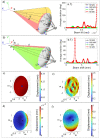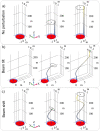Swarm of lightsail nanosatellites for Solar System exploration
- PMID: 37949919
- PMCID: PMC10638386
- DOI: 10.1038/s41598-023-46101-3
Swarm of lightsail nanosatellites for Solar System exploration
Abstract
This paper presents a study for the realization of a space mission which employs nanosatellites driven by an external laser source impinging on an optimized lightsail, as a valuable technology to launch swarms of spacecrafts into the Solar System. Nanosatellites propelled by laser can be useful for heliosphere exploration and for planetary observation, if suitably equipped with sensors, or be adopted for the establishment of network systems when placed into specific orbits. By varying the area-to-mass ratio (i.e. the ratio between the sail area and the payload weight) and the laser power, it is possible to insert nanosatellites into different hyperbolic orbits with respect to Earth, thus reaching the target by means of controlled trajectories in a relatively short amount of time. A mission involving nanosatellites of the order of 1 kg of mass is envisioned, by describing all the on-board subsystems and satisfying all the requirements in terms of power and mass budget. Particular attention is paid to the telecommunication subsystem, which must offer all the necessary functionalities. To fabricate the lightsail, the thin films technology has been considered, by verifying the sail's thermal stability during the thrust phase. Moreover, the problem of mechanical stability of the lightsail has been tackled, showing that the distance between the ligthsail structure and the payload plays a pivotal role. Some potential applications of the proposed technology are discussed, such as the mapping of the heliospheric environment.
© 2023. The Author(s).
Conflict of interest statement
The authors declare no competing interests.
Figures








References
-
- Gong S, Macdonald M. Review on solar sail technology. Astrodynamics. 2019;3:93–125. doi: 10.1007/s42064-019-0038-x. - DOI
-
- Spröwitz, T. et al. Membrane deployment technology development at DLR for solar sails and large-scale photovoltaics. In 2019 IEEE Aerospace Conference, 1–20 (2019).
-
- Whorton, M., Heaton, A., Pinson, R., Laue, G. & Adams, C. L. Nanosail-D: The first flight demonstration of solar sails for nanosatellites. In 22nd Annual AIAA/USU Conference on Small Satellites (2008).
-
- http://sail.planetary.org/ Last access. 2019. http://sail.planetary.org/.
-
- Mori O, et al. First solar power sail demonstration by IKAROS. Trans. Jpn. Soc. Aeronaut. Space Sci. Aerosp. Technol. Jpn. 2010;8:To_4_25–To_4_31.
LinkOut - more resources
Full Text Sources

